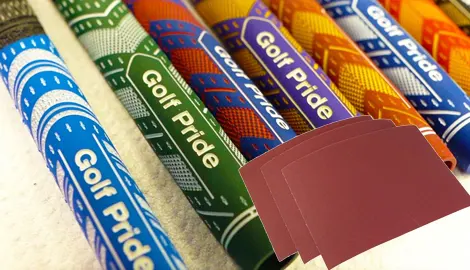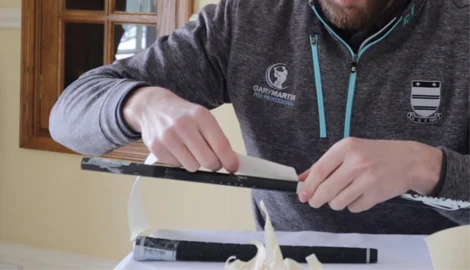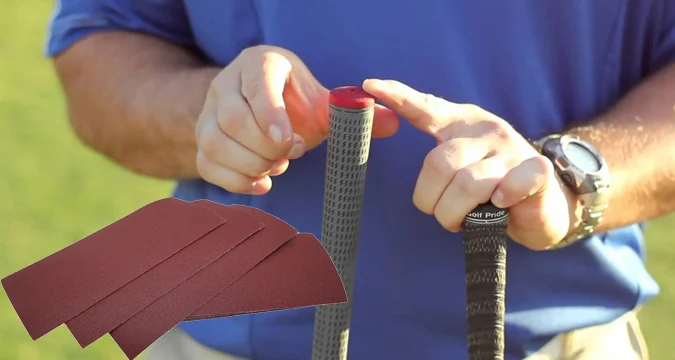Golf grips can become quite slippery after extended use, which can negatively impact your game. After prolonged use, even the finest golf grips can become slippery, resulting in a loss of control over the club and decreased accuracy of shots.
One possible solution might be to use sandpaper on the grips. But can you use sandpaper on golf grips to reduce slipperiness? Sanding on a slippery grip surface will roughen up the surface, providing more friction and allowing for better grip. A few quick swipes with sandpaper are enough to improve grip without hurting the grips.
Sandpaper can help to improve grip by creating a rougher surface for your hands to hold onto. Also, it can help to absorb some of the sweat that can make golf grips slippery. Please keep reading to discover how to use sandpaper on golf grips and whether or not it will work for you.
How Can You Use Sandpaper on Golf Grips to Reduce Slipperiness?

A slippery grip can cause the club to slip out of your hand at the worst possible moment, leading to a wild swing and an unsatisfactory shot. One of the simplest is to sand the grips with sandpaper. Following are the steps for sanding a golf grip:
Step 01. Clean the Golf Club Grip
Cleaning a golf club grip is a quick and easy process that can be done with just a few household items. Start by using a soft stiff brush to remove any dirt particles from the surface of the grip. Then, apply a small amount of dish soap to a sponge and use it to scrub the grip.
Be sure to rinse the sponge frequently to avoid damaging the grip. Now, dry the grip with a towel and apply a small amount of grip cleaner to restore its tackiness.
Step 02. Sand the Golf Grip Lightly
After drying the golf grip, you can sand it lightly with fine-grit sandpaper to reduce its slipperiness. You can wrap a piece of sandpaper around your finger and rub it across the grip in a circular motion.
Now, use the second piece of sandpaper to rub the grip in a back-and-forth motion. To finish, rub the grip side-to-side motion with a third piece of sandpaper.
After sandpapering your golf grip, it should have less slipperiness without being too tacky. Several quick swipes should be sufficient to improve grip without harming the grips.
Step 03. Wipe Away the Dust
The easiest way to wipe away the particles is to use a damp cloth. Start by lightly misting the cloth with water. Then, gently wipe the grip until all the residue has been removed. If there’s still some residue left behind, you can use a mild cleaning solution to break it down.
Simply apply a small amount of solution to the cloth and continue wiping until the grip is clean. Once you’re finished, dry the grip entirely before using it again.
Step 04. Repeat as Needed
The sanding process can be repeated if the grip becomes slippery again. Sand the grips lightly so that they do not become damaged. Giving your clean golf clubs light sand with sandpaper is usually adequate to maintain their grip.
Most golfers will use some sort of sandpaper every three months to ensure that their grips are not getting too slick. You can do this more often if you feel like you need to, but 3 months should be sufficient for most people.
You should also wash your grips every 2-3 weeks. This helps to remove any dirt or grime that may have built up on them and improves their grip.
What are the Potential Risks of Sanding Your Golf Grips?

Sanding your golf club grips can be risky if you’re not careful. So, it’s essential to use the correct type of sandpaper. Coarse sandpaper can damage the grips, while too fine of sandpaper will not remove enough material.
You may take the following risks while sanding your golf grips too hardly:
- Scratches or nicks in the grip: When you sand your golf grips, scratches or nicks are a common problem. This can happen if you’re not careful when sanding, and it can affect the way the grip feels in your hand.
Also, if the grip is not installed correctly, it can cause the club to twist in your hand during your swing. This can lead to inconsistent shots and may even cause injury.
- Abrasion of the surface: Abrasion is the wear and tear of the outermost layer of something due to friction. When you sand your clean golf grips, you put the surface of the grip under many frictions.
This can cause the surface to start to break down and wear away. The more you sand the grips, the more wear and tear will occur.
- Removal of material from the grip: Sanding too aggressively can damage the underlying material, making it more likely to tear in the future. Also, sanding can create tiny tears in the grip surface that can collect dirt and moisture, leading to a loss of traction over time.
- Changes in the tackiness or firmness of the grip: if you sand too much, you can end up with the tacky feel or firmness of the grip material. This can cause the grip to become brittle and more likely to tear quickly.
Besides, if you don’t sand evenly, you may create unevenness in the grip, leading to inconsistencies in your swing.
So, be sure to use just enough pressure to remove the top layer of material without damage. Also, you must be careful not to sand too much of the grip. If you remove too much material, the grip will be too slender and could slip off the club during your swing.
Should You Sand Your Golf Grips With Sandpaper?
If your golf grip is too slippery, you may find that you cannot swing the club as effectively. Due to this, many golfers choose to sand their grips with sandpaper to reduce the slipperiness of their clean golf grips.
By sanding down the grips, you can reduce their diameter and make them more comfortable to hold. Also, sanding can help to improve traction, making it easier to keep a firm grip on the club during your swing.
Sanding is not a good idea if you have a polymer grip because it can damage the material. Fine-grit sandpaper can reduce slipperiness and make your hand’s grip feel more secure for leather or cord grip. Just be sure not to sand too aggressively, or you could damage the new grip.
What is Causing Golf Grips to Slip?
Golf grips are designed to provide a firm, comfortable grip on the club, but over time, they can become slippery and difficult to hold onto. The main culprit behind slippery golf grips is dirt, lubricant, and oil.
Every time you swing your club, these substances are transferred from your sweaty hands to the grip, and over time, they build up and make the grip less effective. Also, hot weather can cause golf grips to slip, as the heat makes the rubber material softer and more pliable.
Also, if you have sunscreen on your hand, this can make the grip slippery. If you’re having trouble with slippery golf grips, you can do a few things to improve the situation immediately, such as:
- Make sure to clean your grips with soapy water or a specialized grip cleaner.
- Avoid storing your clubs in excessively hot or humid conditions.
- If you use sunscreen, wash your hands thoroughly before gripping the club.
- If your grips are still slipping, you can try sanding them lightly to create a more textured surface.
These simple steps can help keep your golf grips in top condition and improve your game.
What is the Best Grit of Sandpaper for Golf Grips?

Many golfers use sandpaper to roughen the surface and provide more traction. But what sandpaper grit is best to use for this purpose? For most golfers, fine-grit sandpaper (such as 100 grit or above) used gently will do the trick.
You don’t want to be too aggressive with the sandpaper, as you don’t want to damage the underlying material. Just a light sanding will rough up the surface and provide the extra grip you need.
If your grips are particularly worn or slippery, you may need to start with a coarser grit (60 to 80) and finish with a finer one (100 to 120). Whatever grit you choose, test it out on a small area first to ensure that it doesn’t damage the grip.
Is it Possible to Rejuvenate Old Golf Grips Using Sandpaper?
If your golf grips are beginning to feel slippery and you’re losing your grip on your game, it might be time to rejuvenate your old grips using sandpaper. Depending on the type of grip, you can use coarse or fine sandpaper to restore the grip’s surface.
You’ll want to use fine sandpaper if you have leather grips to avoid damaging the material. Sandpaper of any coarseness can be used if you have a synthetic grip. Once you’ve chosen the proper grit, simply rub the sandpaper over the entire surface of the grip until it feels smooth again.
Can You Use Rubbing Alcohol for Golf Grips After Sanding?
Applying a fresh coat of rubbing alcohol to sanded golf grips can revitalize them and help to improve your game. Rubbing alcohol will clean the grips and help remove any lingering dirt and grime.
Also, the alcohol will evaporate quickly, leaving behind a dry grip ready for use. For best results, apply a generous amount of alcohol to a clean cloth and rub it vigorously into the grips. Allow the grips to air dry for a few minutes before using them.
Can You Soften Rubber Golf Grips With Sandpaper?
Over time these grips can become complicated and slick, making it challenging to keep a good grip on the club. Fortunately, there is an easy way to soften up rubber grips, but there are a few things you need to do:
- Wash the dirty grips in lukewarm water with soap and remove all the dirt and deposits.
- To roughen the grip, use coarse sandpaper after drying the grip with a dry towel.
- Be careful not to rub the sandpaper too vigorously while scrubbing.
Doing this will help to soften the grip and make it more comfortable to hold. Also, it will help to increase your grip on the club.
Can Lower Grit Sandpaper Hurt Your Golf Grips?
A higher grit will give you a smoother finish and help prolong your grips’ life. But, many golfers don’t realize that using lower grit sandpaper can hurt their grips.
The abrasive nature of the sandpaper can wear away at the soft material of the grips, making them more susceptible to tears and holes.
Also, the sandpaper can cause the grips to lose their tackiness, making it difficult for your hands to stay glued to the club. So it is best to use high grit sandpaper on golf grips to minimize slipperiness.
Topics of Discussion:

